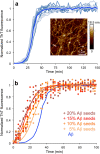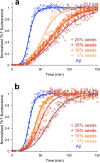Food protein-derived amyloids do not accelerate amyloid β aggregation
- PMID: 36720893
- PMCID: PMC9889329
- DOI: 10.1038/s41598-023-28147-5
Food protein-derived amyloids do not accelerate amyloid β aggregation
Abstract
The deposition of proteins in the form of amyloid fibrils is closely associated with several serious diseases. The events that trigger the conversion from soluble functional proteins into insoluble amyloid are not fully understood. Many proteins that are not associated with disease can form amyloid with similar structural characteristics as the disease-associated fibrils, which highlights the potential risk of cross-seeding of disease amyloid by amyloid-like structures encountered in our surrounding. Of particular interest are common food proteins that can be transformed into amyloid under conditions similar to cooking. We here investigate cross-seeding of amyloid-β (Aβ), a peptide known to form amyloid during the development of Alzheimer's disease, by 16 types of amyloid fibrils derived from food proteins or peptides. Kinetic studies using thioflavin T fluorescence as output show that none of the investigated protein fibrils accelerates the aggregation of Aβ. In at least two cases (hen egg lysozyme and oat protein isolate) we observe retardation of the aggregation, which appears to originate from interactions between the food protein seeds and Aβ in aggregated form. The results support the view that food-derived amyloid is not a risk factor for development of Aβ pathology and Alzheimer's disease.
© 2023. The Author(s).
Conflict of interest statement
The authors declare no competing interests.
Figures







Similar articles
-
Co-aggregation and secondary nucleation in the life cycle of human prolactin/galanin functional amyloids.Elife. 2022 Mar 8;11:e73835. doi: 10.7554/eLife.73835. Elife. 2022. PMID: 35257659 Free PMC article.
-
Exogenous amyloidogenic proteins function as seeds in amyloid β-protein aggregation.Biochim Biophys Acta. 2014 Apr;1842(4):646-53. doi: 10.1016/j.bbadis.2014.01.002. Epub 2014 Jan 14. Biochim Biophys Acta. 2014. PMID: 24440525
-
Elucidating the Structures of Amyloid Oligomers with Macrocyclic β-Hairpin Peptides: Insights into Alzheimer's Disease and Other Amyloid Diseases.Acc Chem Res. 2018 Mar 20;51(3):706-718. doi: 10.1021/acs.accounts.7b00554. Epub 2018 Mar 6. Acc Chem Res. 2018. PMID: 29508987 Free PMC article. Review.
-
How do membranes initiate Alzheimer's Disease? Formation of toxic amyloid fibrils by the amyloid β-protein on ganglioside clusters.Acc Chem Res. 2014 Aug 19;47(8):2397-404. doi: 10.1021/ar500127z. Epub 2014 Jul 16. Acc Chem Res. 2014. PMID: 25029558
-
Structural polymorphism and cytotoxicity of brain-derived β-amyloid extracts.Protein Sci. 2023 May;32(5):e4639. doi: 10.1002/pro.4639. Protein Sci. 2023. PMID: 37051675 Free PMC article. Review.
Cited by
-
Mechanisms and pathology of protein misfolding and aggregation.Nat Rev Mol Cell Biol. 2023 Dec;24(12):912-933. doi: 10.1038/s41580-023-00647-2. Epub 2023 Sep 8. Nat Rev Mol Cell Biol. 2023. PMID: 37684425 Review.
-
The Promising Role of Selenium and Yeast in the Fight Against Protein Amyloidosis.Biol Trace Elem Res. 2025 Mar;203(3):1251-1268. doi: 10.1007/s12011-024-04245-x. Epub 2024 Jun 3. Biol Trace Elem Res. 2025. PMID: 38829477 Free PMC article. Review.
-
Nordic Crops as Alternatives to Soy-An Overview of Nutritional, Sensory, and Functional Properties.Foods. 2023 Jul 5;12(13):2607. doi: 10.3390/foods12132607. Foods. 2023. PMID: 37444345 Free PMC article. Review.
-
Remediation of Metal Oxide Nanotoxicity with a Functional Amyloid.Adv Sci (Weinh). 2024 Jun;11(23):e2310314. doi: 10.1002/advs.202310314. Epub 2024 Apr 6. Adv Sci (Weinh). 2024. PMID: 38582521 Free PMC article.
-
Health concerns about possible long-term effects of legally marketed milk and dairy from animals with intramammary infections.Front Public Health. 2023 Aug 28;11:1200924. doi: 10.3389/fpubh.2023.1200924. eCollection 2023. Front Public Health. 2023. PMID: 37701910 Free PMC article.
References
Publication types
MeSH terms
Substances
LinkOut - more resources
Full Text Sources
Medical

